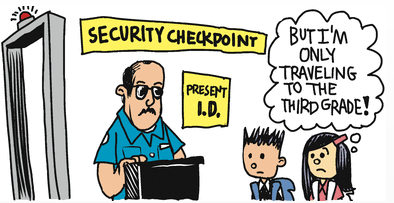| Online: | |
| Visits: | |
| Stories: |

| Story Views | |
| Now: | |
| Last Hour: | |
| Last 24 Hours: | |
| Total: | |
School Surveillance ”the norm” in US and UK; on the Rise in Australia: Study
 |
| Source |
Invasive school surveillance practices are the norm in the UK and USA, and according to a University of Adelaide criminologist, such practices are becoming increasingly popular in Australian schools.
Associate Professor Andrew Hope’s research into school-based surveillance in the UK, USA, Europe and Australia was published in the British Journal of Sociology of Education.
Associate Professor Hope says while the school surveillance revolution is fundamentally fuelled by concerns about the safety and wellbeing of staff and students, these initiatives threaten the inherent nature of schooling.
“An estimated 1.28 million students are fingerprinted in the UK, largely for daily registration purposes; there is an excess of 106,000 closed-circuit television (CCTV) cameras installed in English, Welsh and Scottish secondary schools; while students in a USA high school use pedometers to ensure that they meet their gym class’s physical activity requirement,” says Associate Professor Hope, Head of the Department of Gender Studies and Social Analysis at the University of Adelaide.
“In most cases, school surveillance initiatives are introduced to protect students, and while the safety of children is important, we must not lose sight of their rights to privacy,” he says. “Excessive use of surveillance devices can threaten the values of a progressive education, undermine trust, stigmatise individuals and limit the potential for student engagement.”
Associate Professor Hope says surveillance in Australian schools is steadily growing, with increased safety concerns, including fear of homeland terrorism, influencing people’s attitudes to surveillance.
“In Melbourne, some primary school students who walk or cycle are required to swipe a card when they arrive to school, which generates an automatic email notifying parents, and dataveillance (surveillance using data) has been used to estimate student disengagement and dropout rates,” says Associate Professor Hope.
 “Surveillance is largely used to reduce people’s fear of crime and disorder. Many have differing views about the level of surveillance they think is appropriate, but generally people largely ignore surveillance technologies in their everyday lives until they intrude in a negative manner,” he says.
“Surveillance is largely used to reduce people’s fear of crime and disorder. Many have differing views about the level of surveillance they think is appropriate, but generally people largely ignore surveillance technologies in their everyday lives until they intrude in a negative manner,” he says.
Associate Professor Hope says Australia needs to be careful it doesn’t follow the path of the UK or USA.
“Discussion in educational communities is required prior to new monitoring technologies being introduced into Australian schools. This is not only because of the possible impact on schools but also as these intrusive devices then find their way into work and public places,” says Associate Professor Hope.
“However, it’s also important to remember many already ‘play with surveillance’ by happily using social media,” he says.
Associate Professor Hope is an internationally renowned surveillance and criminology researcher and will be running new criminology courses at the University of Adelaide’s School of Social Sciences in 2015.
Source: University of Adelaide
Source: http://www.activistpost.com/2015/02/school-surveillance-norm-in-us-and-uk.html



